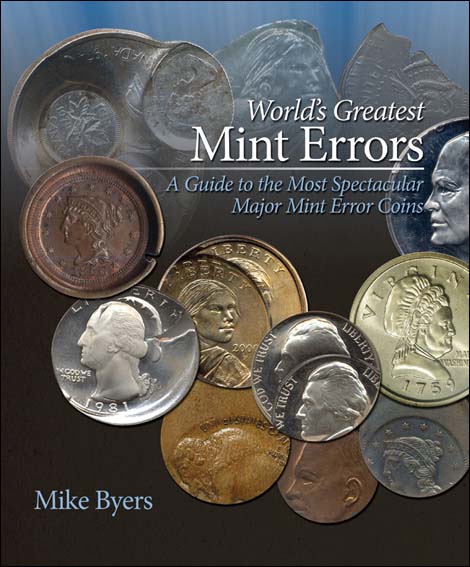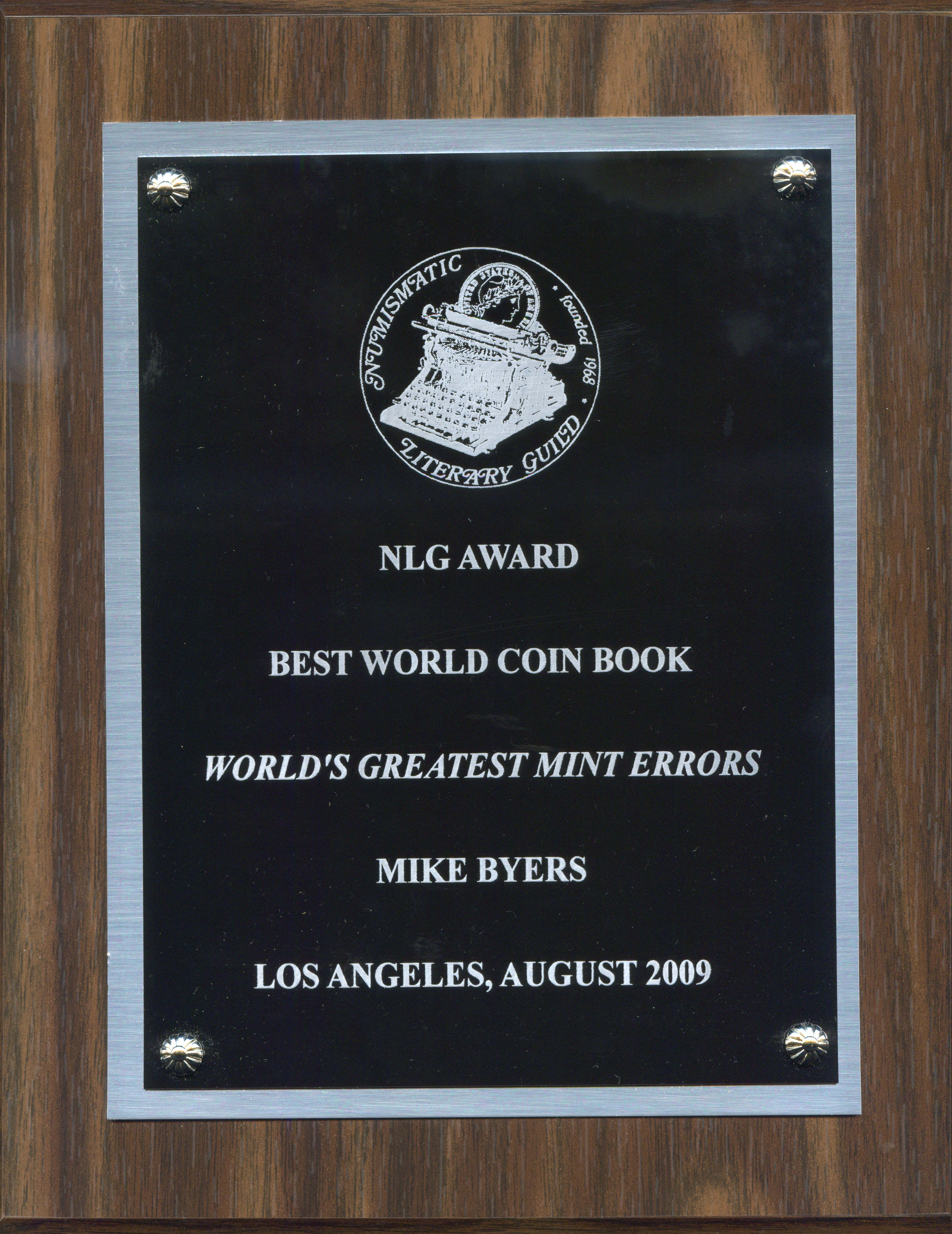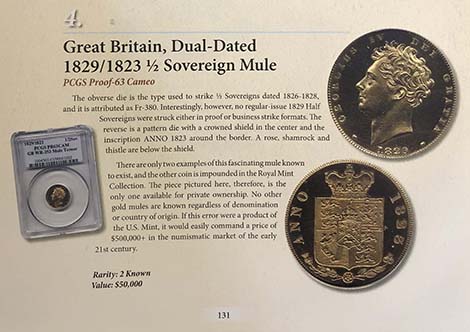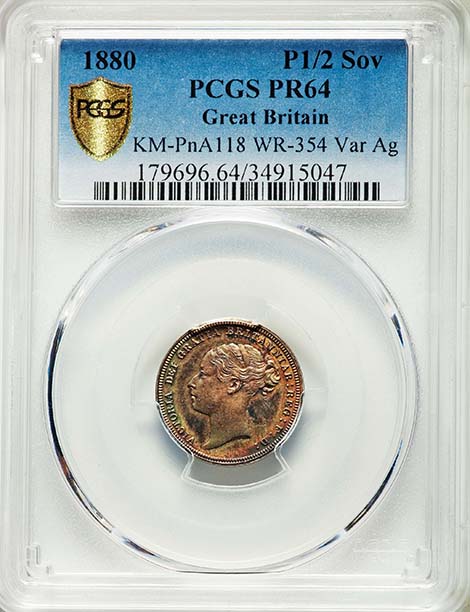

 This piece is the ONLY known certified example and the ONLY known piece as well. The obverse was struck from the regular obverse die intended for the Sixpence issue. The reverse was struck from an experimental reverse die, intended for the proof Half Sovereign issue.
This piece is the ONLY known certified example and the ONLY known piece as well. The obverse was struck from the regular obverse die intended for the Sixpence issue. The reverse was struck from an experimental reverse die, intended for the proof Half Sovereign issue.
 The Royal Mint in London struck this mule with the reverse die exactly as it was designed in 1817, the first year of the appearance of St. George and the Dragon. This design of St. George and the Dragon is different than the design on the reverse of a 1880 Half Sovereign. The reverse design of a modified St. George and the Dragon appeared on Half Sovereigns starting in 1871, but this mule has the design from 1817. Fascinating.
The Royal Mint in London struck this mule with the reverse die exactly as it was designed in 1817, the first year of the appearance of St. George and the Dragon. This design of St. George and the Dragon is different than the design on the reverse of a 1880 Half Sovereign. The reverse design of a modified St. George and the Dragon appeared on Half Sovereigns starting in 1871, but this mule has the design from 1817. Fascinating.
 PCGS certified and authenticated this extremely rare proof off-metal mule pattern as Proof 64. As noted on the insert, it is listed in Krause PnA118 and also cf. WR-354 Var Silver. Wilson and Rasmussen (WR) wrote the English Pattern Trial and Proof Coins in Gold 1547-1968 in 2000. It is the reference book used for English gold. Although WR lists it as R7, one or two known, the only known gold example is in the Royal Mint Collection. This is the only known documented silver piece after 140 years and it is unique.
PCGS certified and authenticated this extremely rare proof off-metal mule pattern as Proof 64. As noted on the insert, it is listed in Krause PnA118 and also cf. WR-354 Var Silver. Wilson and Rasmussen (WR) wrote the English Pattern Trial and Proof Coins in Gold 1547-1968 in 2000. It is the reference book used for English gold. Although WR lists it as R7, one or two known, the only known gold example is in the Royal Mint Collection. This is the only known documented silver piece after 140 years and it is unique.
 It has been preserved since it was struck and is totally original with dark and deep iridescent toning. During this time period the Royal Mint experimented with different engravers who produced a few fascinating and mysterious patterns, die trials, mules and off-metal strikes. This mule combines Wyon's depiction of Queen Victoria (the adopted design for the Sixpence obverse) with Pistrucci's iconic scene of St. George slaying the Dragon (reverse exactly as it was adopted and used in 1817).
It has been preserved since it was struck and is totally original with dark and deep iridescent toning. During this time period the Royal Mint experimented with different engravers who produced a few fascinating and mysterious patterns, die trials, mules and off-metal strikes. This mule combines Wyon's depiction of Queen Victoria (the adopted design for the Sixpence obverse) with Pistrucci's iconic scene of St. George slaying the Dragon (reverse exactly as it was adopted and used in 1817).
 Recently Heritage Auctions sold a 1875 proof Sovereign mule struck in silver and muled with a Shilling obverse for $23,500. It had a R-6 rarity rating meaning there are 3 or 4 known, with 2 certified.
Recently Heritage Auctions sold a 1875 proof Sovereign mule struck in silver and muled with a Shilling obverse for $23,500. It had a R-6 rarity rating meaning there are 3 or 4 known, with 2 certified.
 Since this is the only known and only certified Half Sovereign mule from 1880, this is a once-in-a-lifetime opportunity to acquire an extremely rare proof Half Sovereign off-metal mule struck at the Royal Mint. This unique mule was struck during a time of experimental design, denominations, metals and die pairings. This mule belongs in the finest collection of Great Britain numismatic rarities or in a collection of unique and historical die trials, patterns and experimental coinage from Great Britain.
Since this is the only known and only certified Half Sovereign mule from 1880, this is a once-in-a-lifetime opportunity to acquire an extremely rare proof Half Sovereign off-metal mule struck at the Royal Mint. This unique mule was struck during a time of experimental design, denominations, metals and die pairings. This mule belongs in the finest collection of Great Britain numismatic rarities or in a collection of unique and historical die trials, patterns and experimental coinage from Great Britain.

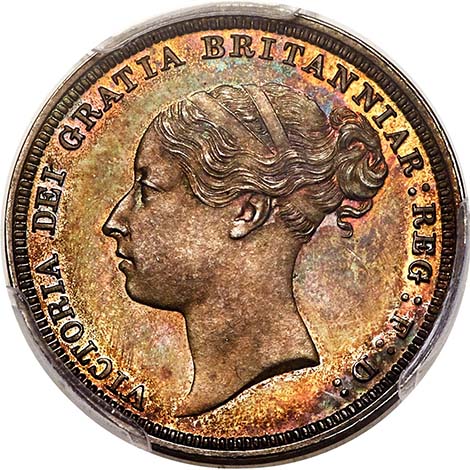
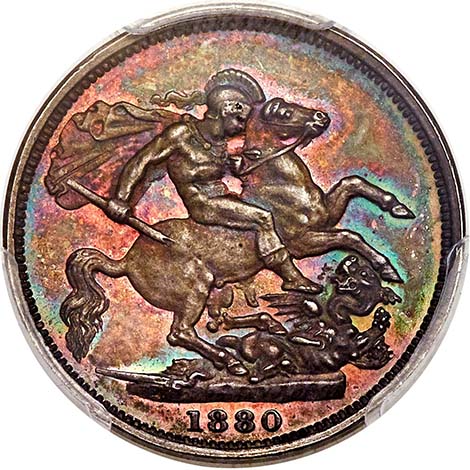
Here is the reverse of 1817 Half Sovereign showing iconic design
of St. George and the Dragon, used on this mule:
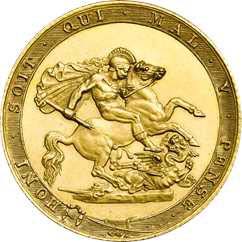
Reverse of 1871 Half Sovereign showing modified design
of St. George and the Dragon, but not used on this mule.
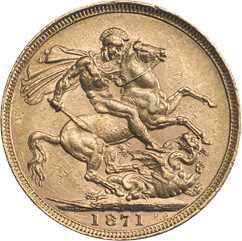

Recently I sold a different Great Britain Gold Half Sovereign Mule. It also is one of two known and was muled with a 1829 obverse die with a 1823 reverse die.
1829/1823 Great Britain Half Sovereign
Proof Gold Mule
1 of 2 Known
PCGS PR 63 Cameo
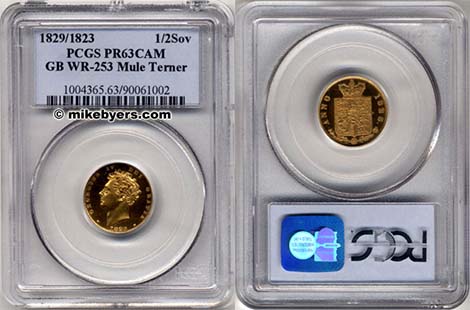

This Proof Gold Half Sovereign Mule was featured in my NLG Award winning book,
World's Greatest Mint Errors on page 131:
